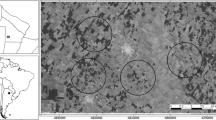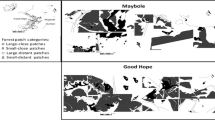Abstract
The black stork Ciconia nigra is listed as a focal species for guiding forest management in Estonia, where forestry has recently intensified and the stork population has suffered a twofold decline. We explored a possible link between the decline of the population and man-induced changes in forest structure, by analysing nesting of the species in relation to forest cover, edge effects and stand structure. Although the storks had distinct habitat preferences (old remote stands near rivers and a certain distance far from ecotones in well-forested landscapes), these were hardly reflected in site re-occupancy and productivity. Therefore, changes in forest structure are probably not responsible for the population decline, although preferences for specific forest environments may limit the range of potential nest sites. The results indicated that edge avoidance cannot be considered a species-specific feature over large areas and clear habitat preferences are not necessarily related with the present success of a population. We also suggest that lists of focal species should be regularly updated and validated in the field.
Similar content being viewed by others
References
P. Angelstam J.-M. Roberge A. Lõhmus M. Bergmanis G. Brazaitis M. Breuss et al. (2004) ArticleTitleHabitat suitability modelling and focal species – a review of habitat parameters for forest birds in the Baltic Sea region Ecological Bulletins 51 427–454
R.A. Askins M.J. Philbrick D.S. Sugeno (1987) ArticleTitleRelationship between the regional abundance of forest and the composition of forest bird communities Biological Conservation 39 129–152 Occurrence Handle10.1016/0006-3207(87)90030-9
D.J. Bender T.A. Contreras L. Fahrig (1998) ArticleTitleHabitat loss and population decline: a meta-analysis of the patch size effect Ecology 79 517–533
InstitutionalAuthorNameBirdLife International/European Bird Census Council (2000) European Bird Populations: Estimates and Trends BirdLife International CambridgeUK
R.G. Clark D. Shutler (1999) ArticleTitleAvian habitat selection: pattern from process in nest-site use by ducks? Ecology 80 272–287
S. Cramp K.E.L. Simmons (Eds) (1977) The Birds of the Western Palearctic, Vol. 1. Oxford University Press OxfordUK
M. Cieslak (1988) ArticleTitleNest sites of black stork in Lasy JanowskieProv Tarnobrzeg. Notatki Ornitologiczne 29 227–231
J. Del Hoyo A. Elliott J. Sargatal (Eds) (1992) Handbook of the Birds of the WorldVol. 1. Lynx Editions BarcelonaSpain
E. Drobelis (1993) ArticleTitleOn the biology and protection of the black stork (Ciconia nigra L.) in Lithuania Acta Ornithologica Lituanica 7–8 94–99
D.J. Flashpohler S.A. Temple R.N. Rosenfield (2001) ArticleTitleSpecies-specific edge effects on nest success and breeding bird density in a forested landscape Ecological Applications 11 32–46
M.L. Hunter SuffixJr. (Eds) (1999) Maintaining Biodiversity in Forest Ecosystems Cambridge University Press CambridgeUK
V.V. Ivanovsky (1990) Status of the black stork population in the Vitebsk region in 1983–1988 Storks: Distribution, Ecology, Protection Navuka i TehnikaMinsk Byelorussia 206–211
R.J. Lambeck (1997) ArticleTitleFocal species: a multi-species umbrella for nature conservation Conservation Biology 11 849–856
D.B. Lindenmayer A.D. Manning P.L. Smith H.P. Possingham J. Fischer I. Oliver et al. (2002) ArticleTitleThe focal-species approach and landscape restoration: a critique Conservation Biology 16 338–345
A. Lõhmus (2002) ArticleTitleThe lack of old-growth forest – a threat to Estonian biodiversity Proceedings of the Estonian Academy of Sciences. Biology. Ecology 51 138–144
Lõhmus A. 2003. Habitat preferences and habitat quality for birds of prey: from principles to applications. Dissertationes Biologicae Universitatis Tartuensis 78.
A. Lõhmus U. Sellis (2001) ArticleTitleForaging habitats of the black stork in Estonia Hirundo 14 109–112
Lõhmus A. and Sellis U. Nest trees – a limiting factor for the black stork in Estonia. In: Proceedings of the 3rd International Black Stork Conference. Forneau Saint-Michel, Belgium in-press.
G. Malan E.R. Robinson (2001) ArticleTitleNest-site selection by black sparrowhawks Accipiter melanoleucus: Implications for managing exotic pulpwood and sawlog forests in South Africa Environmental Management 28 195–205 Occurrence Handle1:STN:280:DC%2BD3MzovVymtw%3D%3D Occurrence Handle11443384
D.A. McCallum F.R. Gehlbach (1988) ArticleTitleNest-site preferences of flammulated owls in western New Mexico Condor 90 653–661
D. McCollin (1998) ArticleTitleForest edges and habitat selection in birds: a functional approach Ecography 21 247–260
G.K. Meffe C.R. Carroll (1994) Principles of Conservation Biology Sinauer Associates SunderlandMassachusetts
I. Newton (1979) Population Ecology of Raptors PoyserBerkhamsted UK
Petrinš A.J. 1986. Some characteristics of the location of black stork nests, and their importance for the construction of artificial nests. In: Abstracts of the 9th Ornithological Conference of the Soviet Union, Vol. 2. Leningrad, pp. 141–142 (in Russian).
F. Pojer (1996) The black stork in Czech Republic: present status and ecology 2nd International Conference on the Black Stork, Abstracts ADENEX MéridaSpain
P. Profus (1994) Black stork, Ciconia nigra G.M. Tucker M.F. Heath (Eds) Birds in Europe: Their Conservation Status BirdLife International CambridgeUK 98–99
R. Rosenvald A. Lõhmus (2003) ArticleTitleNesting of the black stork (Ciconia nigra) and white-tailed eagle (Haliaeetus albicilla) in relation to forest management Forest Ecology and Management 185 217–223
P. Sackl (1993) ArticleTitleAktuelle Situation, Reproduktion und Habitatansprüche des Schwarzstorchs Schriftenreihe für Umwelt und Naturschutz im Kreis Minden-Lübecke 2 54–63
U. Sellis (2000) ArticleTitleWill the black stork remain to breed in Estonia? Hirundo 13 19–30
F. Sergio P. Pedrini L. Marchesi (2003) ArticleTitleSpatio-temporal shifts in gradients of habitat quality for an opportunistic avian predator Ecography 26 243–255
T.D. Sisk C.R. Margules (1993) Habitat edges and restoration: methods for quantifying edge effects and predicting the results of restoration efforts D.A. Saunders R.J. Hobbs P. Ehrlich (Eds) Nature Conservation 3: Reconstruction of Fragmented Ecosystems Surrey Beatty & Sons Sydney, Australia 57–69
S. Skuja R.R. Budrys (1999) ArticleTitleNesting sites of black stork, lesser spotted eagle and common buzzard and their nest exchange in the forests of northnorth-east and central Lithuania Baltic Forestry 5 67–74
M. Strazds J. Lipsbergs A. Petrinš (1990) Black stork in Latvia – numbers, distribution and ecology Baltic Birds 5, Vol. 2. Zinatne RigaLatvia 174–179
M. Strazds W. Van den Bossche P. Sackl A. Tischechkin (1996a) Population trends of the black stork in Europe 2nd International Conference on the Black Stork, Abstracts ADENEX MéridaSpain
M. Strazds H. Meiers A. Petrinš (1996b) Analysis of ecological conditions of breeding habitat of the black stork in Latvia 2nd International Conference on the Black Stork, Abstracts ADENEX MéridaSpain
W.J. Sutherland (2000) The conservation Handbook: ResearchManagement and Policy Blackwell Science OxfordUK
Ü. Väli R. Treinys A. Lõhmus (2004) ArticleTitleGeographic variation in macrohabitat use and preferences of the Lesser Spotted Eagle Aquila pomarina Ibis 146 661–671
Ü. Viilup (2000) Forest resources Yearbook Forest 2000. Metsakaitse- ja Metsauuenduskeskus TartuEstonia 1–38
M.-A. Villard (1998) ArticleTitleOn forest-interior species, edge avoidancearea sensitivity, and dogmas in avian conservation Auk 115 801–805
S.P. Wright (1992) ArticleTitleAdjusted P-values for simultaneous inference Biometrics 48 1005–1013
Author information
Authors and Affiliations
Corresponding author
Rights and permissions
About this article
Cite this article
Lõhmus, A., Sellis, U. & Rosenvald, R. Have recent changes in forest structure reduced the Estonian black stork Ciconia nigra population?. Biodivers Conserv 14, 1421–1432 (2005). https://doi.org/10.1007/s10531-004-9667-5
Received:
Accepted:
Issue Date:
DOI: https://doi.org/10.1007/s10531-004-9667-5




